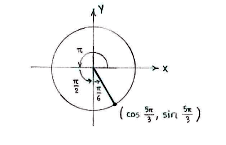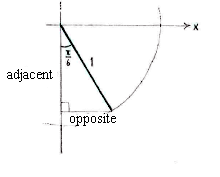Lösung 4.2:4b
Aus Online Mathematik Brückenkurs 1
We start by subtracting \displaystyle 2\pi from \displaystyle \frac{11\pi }{3}, so that we get an angle between \displaystyle o and \displaystyle 2\pi . This doesn't change the cosine value
\displaystyle \cos \frac{11\pi }{3}=\cos \left( \frac{11\pi }{3}-2\pi \right)=\cos \frac{5\pi }{3}
Then, by rewriting
\displaystyle \frac{5\pi }{3}
as a sum of
\displaystyle \pi
- and
\displaystyle \frac{\pi }{2}
-terms
\displaystyle \frac{5\pi }{3}=\frac{3\pi +\frac{3}{2}\pi +\frac{1}{2}\pi }{3}=\pi +\frac{\pi }{2}+\frac{\pi }{6}
we see that \displaystyle \frac{5\pi }{3} is an angle in the fourth quadrant which makes an angle \displaystyle \frac{\pi }{6} with the negative \displaystyle y -axis.
With the help of a triangle and a little trigonometry, we can determine the coordinates for the point on a unit circle which corresponds to the angle \displaystyle \frac{5\pi }{3} .
The point has coordinates \displaystyle \left( \frac{1}{2} \right.,\left. -\frac{\sqrt{3}}{2} \right) and \displaystyle \cos \frac{11\pi }{3}=\cos \frac{5\pi }{3}=\frac{1}{2}.


